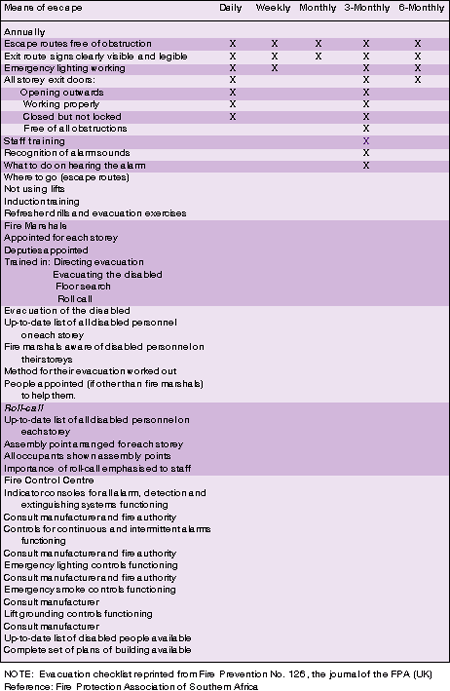
A properly planned and regularly practiced evacuation procedure is necessary for all buildings, so that occupants will know how to make an efficient and orderly escape during an emergency.
Any area affected by heat, flame or smoke should be evacuated and where there is any doubt, the entire building should be evacuated. Evacuation can only be successfully undertaken if there are well constructed marked exits in the buildings.
Objectives
* 2½ minutes is the average time for everyone to reach a place of safety.
* No one should go towards a fire to escape. An alternative route should always be available.
* Everyone should be able to escape by their own unaided efforts. Special attention will have to be given to aged, ill and non-ambulant occupants.
* Escape routes should lead directly to a place of safety.
* A place of safety is an area where people can disperse - it may be outside, in another compartment, a protected staircase or lobby.
Considerations
In planning evacuation procedures, the following must be considered.
* The possible behaviour of a fire with special regard to the spread of smoke.
* The type of risk and number of occupants. People may either be sleeping, be unfamiliar with the building or be very young or aged. The building contents could facilitate rapid fire spread.
* The number of escape routes is determined by dividing the floor area by the recommended floor area required per person. The design density population for an office is, for example, 1 person per 10 m².
* The exit widths must accommodate the occupants to enable them to evacuate within 2½ minutes.
Additional considerations
* An alarm system is essential to initiate evacuation procedures.
* Moving machinery, fuel and gas lines and certain electrical equipment should be shut down by a designated person prior to evacuation.
* Partial or phased evacuation may be initiated in large buildings where total evacuation is impractical. Partial evacuation being the relocation of people to a safe area and phased evacuation, the progressive relocation of people to safe areas - suitable for hospitals.
Procedure
The evacuation plan should be circulated to occupants and management, brief details being displayed on each floor or within each section. It will be necessary to appoint a chief fire marshal (CFM) to direct operations (usually from a control centre). Fire marshals on each floor can supervise evacuation, initially attack the fire and assist the CFM.
The following procedure is a general guide which can be modified to suit the particular building and occupancy.
Marshals and their responsibilities
CFM and Deputy Officer
White hard hat
Responsible for:
* Staff training.
* Fire prevention.
* Notifying and meeting the brigade.
* Deciding to evacuate.
* Organising personnel for evacuation duties.
Floor or section fire marshals
Red hard hat
Responsible for:
* Notifying the CFM of the location and extent of the fire.
* Fighting the fire.
* Safe evacuation of all personnel from their own floor or section.
* Searching of area for personnel not reacting to evacuation signal.
Deputy floor or section fire marshals
Yellow hard hat
Responsible for:
* Assisting the floor or section wardens in carrying out their tasks.
If a multistorey building is to be completely evacuated, the following events should be followed as closely as possible.
When a fire breaks out, people in the emergency centre - in this case the reception area on the ground floor - are notified. They will then:
* Inform the fire brigade.
* Contact the CFM.
* Initiate the evacuation alarm.
* Recall lifts to ground floor.
The CFM will:
* Take charge of the emergency centre.
* Co-ordinate building services such as lifts, booster pumps, airconditioning, power supplies and fire suppression installations.
* Liaise with the fire department.
On the fire floor, fire marshals will:
* Begin evacuating employees.
* Attack the fire if expedient to do so.
The duties of fire marshals during an emergency are:
* Muster occupants and guide them to correct exits.
* Prevent people from returning for personal possessions.
* Prevent people using lifts.
* Control congestion in stairways.
* Assist the old, infirm, or injured.
* Search floor area, toilets and landings between floors.
* Close doors particularly staircase doors.
* Report to the CFM that floor is clear.
* Guide occupants to assembly area.
* Take roll call (this procedure is not always appropriate).
Once the emergency is over, staff will be dismissed to return to their work stations or to go home depending on circumstances. This will only happen when the 'all clear' has been given by the fire department, chief fire marshal or management, whichever is applicable.


© Technews Publishing (Pty) Ltd. | All Rights Reserved.